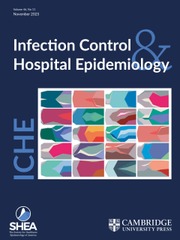Crossref Citations
This article has been cited by the following publications. This list is generated based on data provided by Crossref.
Bolyard, Elizabeth A.
Tablan, Ofelia C.
Williams, Walter W.
Pearson, Michele L.
Shapiro, Craig N.
and
Deitchman, Scott D.
1998.
Guideline for Infection Control in Healthcare Personnel, 1998.
Infection Control & Hospital Epidemiology,
Vol. 19,
Issue. 6,
p.
407.
Petignat, Christiane
Blanc, Dominique S.
and
Francioli, Patrick
1998.
Occult Nosocomial Infections.
Infection Control & Hospital Epidemiology,
Vol. 19,
Issue. 8,
p.
593.
Bolyard, Elizabeth A.
Tablan, Ofelia C.
Williams, Walter W.
Pearson, Michele L.
Shapiro, Craig N.
and
Deitchman, Scott D.
1998.
Guideline for Infection Control in Healthcare Personnel, 1998.
Infection Control & Hospital Epidemiology,
Vol. 19,
Issue. 6,
p.
407.
LaVela, Sherri
Goldstein, Barry
Smith, Bridget
and
Weaver, Frances M.
2007.
Working with symptoms of a respiratory infection: Staff who care for high-risk individuals.
American Journal of Infection Control,
Vol. 35,
Issue. 7,
p.
448.

